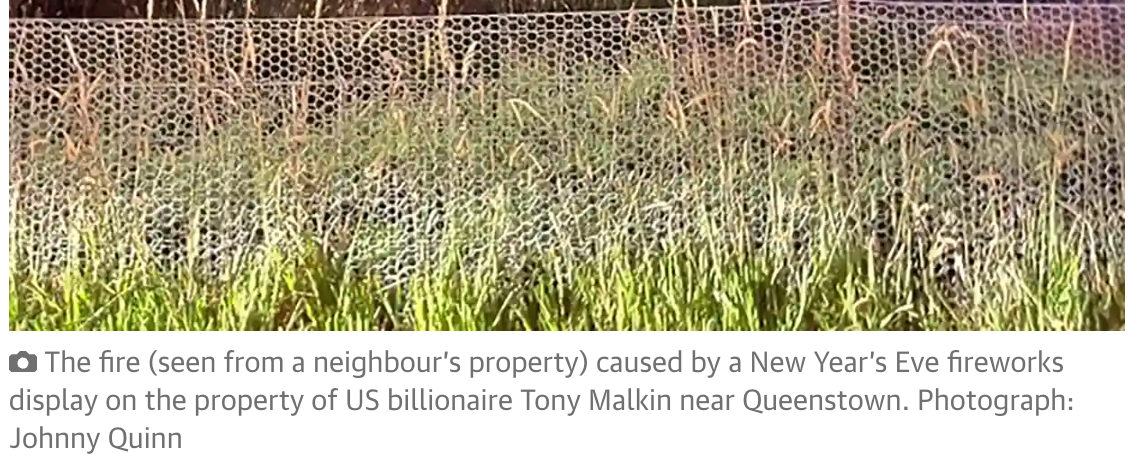Ask LLOG: Furniture?
« previous post | next post »
Bob Ladd wrote to ask about the word furniture, found in a note at the end of an online Guardian story (Ollie Neas, "‘Burned the hill down’: billionaire’s runaway fireworks spark New Zealand furore", 1/3/2023), which read
This article was amended on 3 January 2023. The original furniture said the fireworks display was on Christmas Eve. This was incorrect and has been removed.
That note now has "subheading" in place of "furniture":
And shortly after the original query, Bob sent in the answer — according to the Guardian's own "Newspaper terminology" page, "Page furniture" means "everything on the page except pictures or text of stories".
The term subheading didn't seem quite right to me, because the corrected date information is actually in in a picture caption:
I always through that subheading (or subhead, or whatever) referred to the summary line below the headline, as below in the cited article:
But maybe I'm wrong — the Wiktionary entry suggests that I might be. The Guardian's "Newspaper terminology" page doesn't have an entry for subheading, so there's no answer from that quarter.
Meanwhile, on the furniture front, the Wiktionary entry does give us sense #7:
(journalism) Any material on the page other than the text and pictures of stories.
The OED hasn't caught up with this one yet, but does offer a palette of vaguely analogous senses, including
Apparel, dress, outfit, personal belongings.
Armour, accoutrements, weapons, munitions of war.
The harness, housings, trappings, etc. of a horse or other draught animal […] Similarly, the hood, bells, etc. of a hawk.
Hangings and ornamental drapery; also, the coverlets and linen for a bed.
Implements, tools, utensils; rigging, stores, and tackle of a ship; military engines and defensive works.
…and especially:
Accessories, appendages. (Formerly also plural in the same sense.) Now only technical in specific applications; used, e.g., for the finger-plates, handles, locks, etc. of a door; the plates and handles, etc. of a coffin; and the like; spec. the mountings of a rifle.
plural. Adjuncts or condiments of a salad.
(Printing), the wooden inclosing strips and quoins which surround the matter in the chase.




Dick Margulis said,
January 3, 2023 @ 11:14 am
I understood the word immediately as being an extension of the (letterpress) printing term. Newspaper editorial departments have greater intimacy with the production departments than exists in most other types of publishing, and the crossover of printers' jargon would be expected. It's not much of a leap from wooden spacers used to fill out a forme to subheads, decks, and pull quotes used to fill out a page, especially fifty years after the last time anyone saw an example of the former.
One of the most remarkable aspects of a printed newspaper is that every day, when it goes to press, all the pages are filled to the margins. Furniture helps.
James E said,
January 3, 2023 @ 11:45 am
What you're calling a "subheading" would usually be a "standfirst" in UK newspaper terminology. I'd understand "subheading" to be a small headline in the body copy to break it up, aka a "crosshead" as in that Guardian terminology guide.
(I've worked at a couple of UK newspapers including the Guardian but there may be variations in terminology across the industry – certainly I've heard one or two people here call a standfirst a "deck" or "dek", which seems to be an American thing).
David L said,
January 3, 2023 @ 11:59 am
Many years ago I worked for a British publication (a weekly, not a daily), and we always referred to picture captions as captions; subheads (or subheds) were exactly what you say they are.
I never came across the word 'furniture.' We were in the process of moving (painfully) from old-style linotype machines to yer fancy digital layout and photolitho. It may be that some publications held on to the old jargon longer than others.
John O'Meara said,
January 3, 2023 @ 1:39 pm
The words between the headline and the text are known either as a precede or a standfirst.
Daniel Barkalow said,
January 3, 2023 @ 3:35 pm
My immediate thought was that the Canadian contemporary, mid-century, and modern furniture company Article stopped sponsoring the Guardian, so they did a search-and-replace that hit a few too many things.
JPL said,
January 3, 2023 @ 4:58 pm
Isn't this (the original correction note), since it was directed at the reading public, a case of what is usually identified here at LLog as "nerdview"?
William Berry said,
January 3, 2023 @ 9:01 pm
Presumably, with “I always through” (my emphasis), in the fifth paragraph, “I always thought” was intended.
VVOV said,
January 3, 2023 @ 9:02 pm
I think it's definitely nerdview. It's not merely "jargon", since even if the reader knows what the word "furniture" means in this context ("text other than the body of the article"), it doesn't tell them *where* on the page to find the erratum.
"The original photo caption said…" seems like a natural and better alternative
William S. Berry said,
January 3, 2023 @ 9:08 pm
Please forgive the double (now triple) posting. Really strange stuff going on with my iPhone.
Trivial observation, anyway.
As you were, then.
mike said,
January 3, 2023 @ 9:46 pm
Interestingly, there's a kinda-sorta similar term in computer GUI design—"chrome" refers to "basic structural elements used in a graphical user interface, such as window frames and scroll bars, as opposed to the content." (https://en.wiktionary.org/wiki/chrome#Noun).
Tim Leonard said,
January 3, 2023 @ 10:48 pm
In the civic space, "street furniture" is things like trash barrels, mail boxes, street lamps, and traffic signs.
John Swindle said,
January 4, 2023 @ 12:44 am
Meanwhile for furniture in the sense of tables and chairs and beds some other Germanic, Romance, Slavic, and Baltic languages have words like Möbel, møbler, meubles, mueble, mobila, мебель, and mēbeles. Others use words with unrelated roots, but I can't think offhand of any that call it anything like "furniture" until, Google Translate reminds me, you get to North Indian languages.
Brett said,
January 4, 2023 @ 1:13 am
I don't remember coming across furniture in this newspaper sense, but my time at The Tech was long after the days of physical typesetting.
When I think of novel senses of furniture, however, the first thing likely to come to mind is the creepy usage in Soylent Green. A powerful man's apartment comes with a young woman as part of the package: "furniture," they call her. And just like Charlton Heston's detective character steals food from the apartment of the man whose death he is investigating, he also has sex with the girl who is left alone there after the occupant's death. In the credits, most of actresses playing the women who belong to the other units in the deceased's posh apartment complex are just listed collectively as "The Furniture Girls."
Stephen Goranson said,
January 4, 2023 @ 9:41 am
From the used furniture department, Francis Bacon, Of the Advancement of Learning:
"…behold this stately canopy of heaven, and the Furniture of the World…."
Bob Ladd said,
January 4, 2023 @ 10:53 am
@JPL: Yes, when I first sent this question to MYL, I identified "nerdview" as a possible explanation. That, or else some bizarre auto-correct error (what in the early days of LLog was known as a "Cupertino").
Garrett Wollman said,
January 4, 2023 @ 8:49 pm
The (AmE) newspaper jargon for a photo caption is, oddly enough, "cutline". I would probably ask Ed Latham for the BrE subeditor's view.
Rodger C said,
January 5, 2023 @ 3:04 pm
I suppose a "cutline" is a line of text accompanying what used to be a woodcut.
Taylor, Philip said,
January 10, 2023 @ 6:11 am
"The OED hasn't caught up with this one yet". Untrue, Mark — unclear how you might have reached that conclusion, as all of the following also appeared in the 1989 edition :
Even tho' my own involvement with printing has been little compared to many who have commented here, I was familiar with the use of "furniture" in the printing sense.